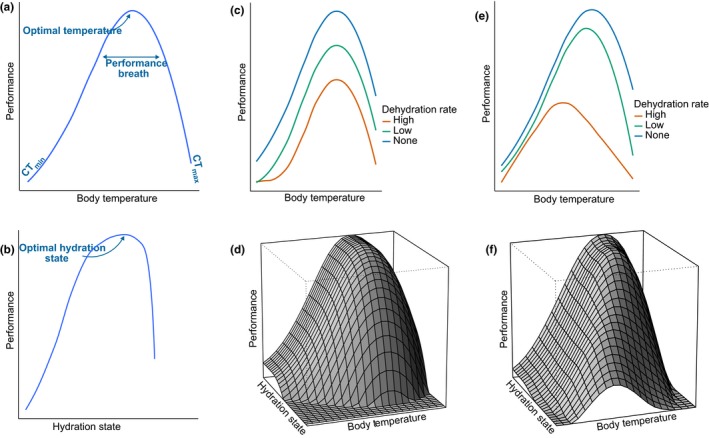Figure 2.

Performance curves. A performance curve is an empirical curve describing the relationship between an organism's performances (a functional trait measuring whole‐organism capacity, behavioral trait, or fitness measurement) and the individual state such as its body temperature (thermal performance curve) or its hydration state (hydric performance curve). (a) Hypothetical thermal performance curve. Thermal performance curves are typically characterized by a linear to geometric growth with increasing body temperature until a maximum is reached at an optimal range of temperatures. This is then followed by a rapid performance decrease at body temperatures above the optimum, meaning that a small increase above the optimum can be lethal (Dowd et al., 2015; Huey & Kingsolver, 1989). Critical thermal limits (CTs) are the lower (CTmin) and upper temperature thresholds (CTmax) beyond which animals die. (b) Hypothetical hydric performance curve. The hydric performance curves can be calculated from studies of dehydration and describe the relationship between an animal performance and hydration state. Examples of such curves can be found in studies of maximal locomotor capacities in dehydrated amphibians (Anderson & Andrade, 2017; Mitchell & Bergmann, 2016; Preest & Pough, 1989) and of muscular and cognitive performances in endotherms (Cheuvront & Kenefick, 2014). The common pattern is that performances are maximized when water is provided at libitum (i.e., optimal hydration state) and decrease rapidly with dehydration state. Hyperhydration can also lead to performance loss due to the mass effects and changes in the osmotic balance, especially in some insects with water excess due to a diet rich in water and high metabolic water production (Chown & Nicolson, 2004). (c–f) Hypothetical thermo‐hydroregulation performance curves. (c, d) Here, performances curves are determined additively by hydration state and body temperature. The optimal body temperature for performance remains the same whatever the hydration state. Performance decreases when temperature and hydration state departs from their optimal values. (e, f) Here, performances curves are determined nonadditively by water balance and body temperature. Optimal body temperature for performance decreases when animals are more dehydrated because dehydration changes the thermal sensitivity of cell and tissue metabolism or the protection against thermal stress (Akerman, Tipton, Minson, & Cotter, 2016)
